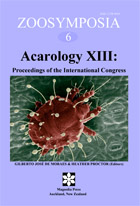Abstract
The “MGP analysis” created by Dr. J. Aoki in 1983 and the “100 oribatid species” system proposed by Aoki in 1995, both for using oribatid communities as bioindicators, are described herein and compared to some other bioindicator protocols. By using the term “naturalness”, Aoki proposed to explain human impact on a gradient of several environments ranging from urban boulevard trees to intact forests.Although using “naturalness” was a vague concept, the idea might reflect the process of plant succession and changes in oribatid assemblages associated with different seral stages. Therefore, the use of oribatid mites as bioindicators might also be based on succession of the oribatid fauna.

